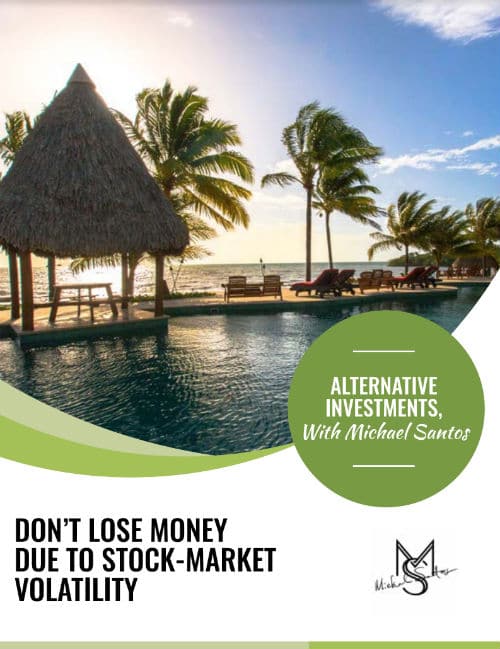LEARN HOW TO INVEST
GUIDE FOR BEGINNERS: Module 8Michael Santos Presents
EVALUATING INVESTMENTS
Use all of your critical-thinking skills to evaluate your investments today and to assess prospects for the growth of your investments in the future.
How to Evaluate Your Investments to Your Money
We’re now at the stage of evaluating investments and figuring out how we can start to cash out of our stake in Liberty Hot Dogs. We’ve been operating this business for five years now. Our financial statements show that we’ve being growing well, with higher sales and higher profits year after year.
Despite the success of Liberty Hot Dogs, the shareholders have not been able to pull any cash out. And it’s time for the owners to begin thinking about how to exit the business.
In this chapter we discuss options that business owners have to cash out, or exit a business. Specifically, we’ll cover the following options:
- Pulling cash out through dividends
- How to sell shares to private investors
- How to sell shares into the public market
How Your Business Generates Cash
Although Liberty Hot Dogs has performed well as a company, investors haven’t yet recuperated much from their investment. The shareholders have done well on paper, as the balance sheet shows. Their investment has grown in value—but they haven’t yet taken out any money.
After five years, the investors in the business may want to take some money out. There are many reasons that investors want to take money out of a business. Our case study, Liberty Hot Dogs, will show us more about those options.
Pulling Cash out through Dividends
Remember that we structured Liberty Hot Dogs as a corporation. The corporation was divided into shares. In the initial structure, I organized Liberty Hot Dogs with 1,500 shares. To raise capital, I sold 500 shares for $1 per share to Frank, who became an investor.
If I wanted to pull cash out through dividends, I would have to issue an equal dividend for every share outstanding. An example will make this clearer.
Let’s say I wanted to issue a total dividend of $1,500. I could issue a dividend of $1 per share. Liberty Hot Dogs would distribute those dividends as follows:
- I own 1,000 shares. Liberty Hot Dogs would issue $1 for each of my shares, or a total of $1,000. I would still own my 1,000 shares.
- Frank owns 500 shares. Liberty Hot Dogs would issue $1 for each of Frank’s 500 shares, for a total of $500. Frank would still own all of his shares in the business.
Obviously, issuing a $1 dividend would deplete cash from Liberty Hot Dogs’ balance sheet. Without cash to reinvest, Liberty Hot Dogs would not grow as quickly. It would not have resources to invest in new hot dog stands. Without new hot dogs, Liberty Hot Dogs would not continue to impressive growth rates.
Other Options for Raising Cash
Investors have other options to raise cash. For example, I could sell Liberty Hot Dogs to a competitor. Many businesses that sell hot dogs want to grow. Rather than opening new stands, competitors could choose a strategy of growing-by-acquisition.
Purchasing Liberty Hot Dogs would lead to an immediate expansion of seven hot dog stands for the new owner.
Selling our business would bring immediate cash to shareholders. Yet by selling, we could lose an opportunity to participate in the continuing growth of the business.
Selling a Statke in the Business
As the founder of Liberty Hot Dogs, I had unique insight into the business and I believed it had a promising future. I wouldn’t want to take cash dividends out of the business because removing cash would remove the ability to grow. Neither would I want to sell the business outright, because I wouldn’t be able to continue creating value.
Another option would be to sell a stake in the business.
The strategy for selling a stake in a mature business differs from selling an equity stake in a startup. When I sold the stake in the startup, the investor was buying into the idea that I presented. Yet after five years of operations, Liberty Hot Dogs had a solid track record.
Business owners that anticipate selling a business later should invest the time and energy to develop solid financial records. Our balance sheet and income statement over time tells the story of the business. They help us to show that we’re not just talking about a growing business. We are all substance, showing that we’ve taken a business idea and turned it into a profitable venture. Investors pay a premium for this type of business.
Creating a Financial Investment Prospectus
In order to sell a portion of the business, we will want to create an investment prospectus. The investment prospectus will detail our vision of the business. We’ll show how the business started and what we’ve learned from operating in the market. We may offer expansion strategies, projecting how revenues and profits will grow in the time to come.
After we create the investment prospectus, we may register the prospectus with authorities like the Securities and Exchange Commission. Or we may ask an accounting firm to audit our prospectus to give investors more confidence that we’re telling the truth about our financial performance. If investors have confidence in the prospectus, they may be willing to purchase shares in the company at a premium.
Investors may come from the private sector, like people we know. Or we may approach private equity firms or hedge funds. Those are “professional investment groups,” meaning they are run by people that specialize in investments. Private equity groups and hedge funds build pools of capital from smaller investors. Professional investors assess all types of investments. When they find investments that make sense to them, they purchase shares, or stakes in the entities.
Public Markets
Finally, another way to cash out of a business would be to take the company public. This approach is frequently known as an Initial Public Offering, or an IPO. Basically, an IPO means that the company is selling shares to the general public.
To take a company public, the business leader would approach an investment banker. The investment banker would review the prospectus and financials of the company. Based on that review, the banker would determine the soundness of the investment. He may coordinate events like an investor roadshow where the business owner would respond to investor questions. Then, the investment banker would begin selling shares to the public and the business would receive proceeds. Shareholders could also receive proceeds by selling shares that they own.
By taking a company public, investors ordinarily sell at the highest possible valuation. For example, take a look at two stocks that trade on the public market:
- Microsoft trades at $106 a share as I write this report (November 2, 2018).
- Netflix trades at $309 a share as I write this report (November 2, 2018).
Both Microsoft and Netflix are publicly traded companies. Which company is more expensive?
- If you answered Microsoft, tell us why.
- If you answered Netflix, tell us why.
Investors know that the information I provided would not be enough to answer which company is more expensive. There is a lot we do not know:
- We do not know how many shares are outstanding.
- We do not know how much profit the company is earning.
- We do not know how fast the company is growing.
As investors, we need a lot of information before we can determine the value of a company.
We know that Microsoft has a total market valuation of $814 billion. It is trading at 50 times earnings.
We know that Netflix has a total market valuation of $135 billion. It is trading at 110 times earnings.
Understanding Stock Multiples
Based on those multiples, we know a lot more. Based on earnings, investors are willing to pay more than twice as much for Netflix than they are willing to pay for Microsoft. For Netflix, investors will pay 110 times the value of each dollar of earnings per share.
If investors were willing to pay 110 times earnings for Liberty Hot Dogs, we would receive an enormous valuation. Liberty Hot Dogs earned $1,500 net, or $1 per share in its fifth year.
If we could get the same valuation as Netflix, investors would value the company at $165,000. That equals $110 a share.
Can you imagine paying $165,000 for a company that earned only $1,500?
- Why do you think investors would be willing to pay so much for a company?
Those are the types of questions you should ask as an investor.
To raise capital, our corporation might issue an additional 1,000 shares that we would sell into the public market. This action could dilute shareholder value. If I wanted to sell some of the shares that I own, I could do so. Each share would be valued equally. Through this strategy of selling to the public market, we could raise capital to grow the company. We could also liquidate some of our holdings to cash in on the success of our investment.
Selling a business, or getting maximum value is a difficult process. There’s a lot more to learn, and many factors to consider. We’ll cover those concepts in the more comprehensive course. For the purposes of becoming an investor, a basic understanding of business will help.
In the next chapter, we’ll recap what we learned. Then we’ll consider why understanding business can make us better investors. It’s all part of our ongoing education with The Introductory Guide to Creating Wealth by Investing!

